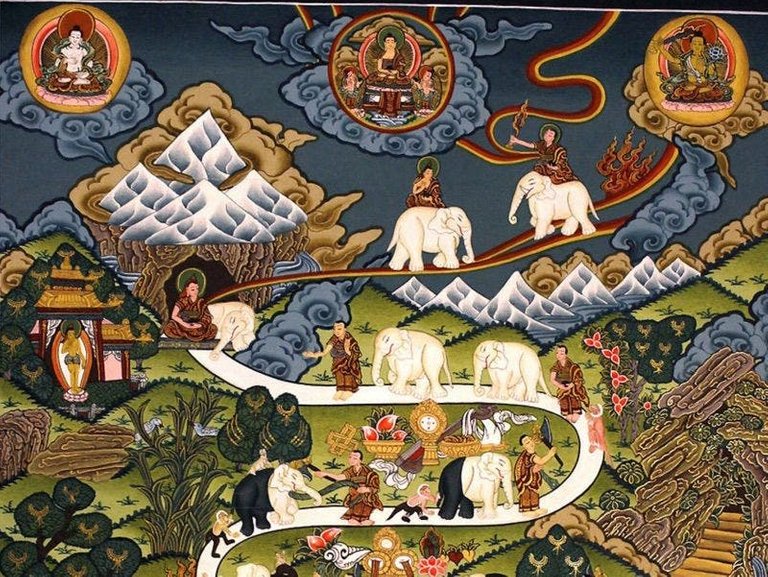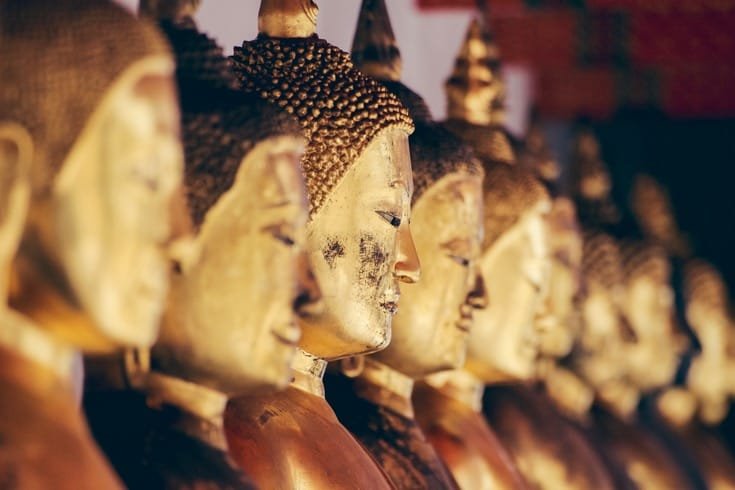It is as if there are two minds in meditation: sheshin who is continuous awareness and drenpa who watches what is happening. For example, when reading aloud, sheshin stays focused on reading and intonation while drenpa makes sure we don't make mistakes while reading. In meditation, when sheshin starts to wander, drenpa warns us. It often happens that when meditating we begin to feel good and congratulate ourselves for it, with which we lose the object of meditation. At this time we must generate drenpa and return to the object.
Es como si hubiera dos mentes en la meditación: sheshin que es consciencia contínua y drenpa que observa lo que ocurre. Por ejemplo, cuando uno lee en voz alta, sheshin se mantiene enfocada en la lectura y la entonación mientras que drenpa se cerciora de que no cometamos errores al leer. En la meditación, cuando sheshin empieza a divagar, drenpa nos advierte. Suele ocurrir que al meditar empezamos a sentirnos bien y a congratularnos por ello, con lo cual perdemos el objeto de meditación. En este momento debemos generar drenpa y volver al objeto.
The third quarter of our attention should be focused on the practice of lhukpa (Wylie: hug pa) which means relaxation, that is, letting go of all solemnity, etiquette and tension so that the mind does not start putting pressure on itself. Thus, the meditator does not force himself to find nirvana like a collection operator pressing the practitioner. It is important to relax any physical or emotional tension. There is nothing to do, nothing to achieve. The mind should not be oriented to goals or emotional states. We must not allow the mind to fantasize about spiritual progress, we must not wait for something special to happen. We abandon all expectations. That is, we should only focus on the simple and boring object without having to add any personal and "deep" meaning. If we generate goals in the present, an imagined future and a narrative of the past appear, making us move away from the objective of the practice: the naked awareness of concepts or chermo sherpa (Wylie: gcer mo'i shes pa).
El tercer cuarto de nuestra atención debe enfocarse en la práctica de lhukpa (Wylie: hug pa) que significa relajación, esto es, soltar toda solemnidad, protocolo y tensión para que la mente no empiece a presionarse a sí misma. Así, el meditador no se obliga a encontrar el nirvana como un telefonista de cobranzas presionando al practicante. Es importante relajar toda tensión física o emocional. No hay nada que hacer, nada que lograr. La mente no debe estar orientada a metas o estados emocionales. No debemos permitir que la mente fantasee con el progreso espiritual, no debemos esperar que suceda algo especial. Abandonamos toda expectativa. Es decir, debemos sólo enfocarnos en el objeto simple y aburrido sin tener que agregar ningún sentido personal y “profundo”. Si generamos metas en el presente, aparece un futuro imaginado y una narración del pasado haciendo que nos alejemos del objetivo de la práctica: la consciencia desnuda de conceptos o chermo sherpa (Wylie: gcer mo´i shes pa).
https://www.learnreligions.com/thmb/bEtM5cdM-1kNHm9U36oujwF_b70=/1500x0/filters:no_upscale():max_bytes(150000):strip_icc():format(webp)/GettyImages-200209650-001-56e7542d5f9b5854a9f96658.jpg
FUENTE
The last quarter of our attention should be focused on the practice of accepting lutrol (Wylie: glod bkrol). This means letting go, not engaging in a state of self-analysis of what is happening in our meditation. We must accept whether our meditation is clear or not. We have to accept ourselves as individuals, accept the world, accept that we breathe. In summary, we are not meditating to flee from what we reject nor to obtain spiritual strength and "subdue" what does not agree with us. Accepting is admitting that we are part of the present and that this links us to everyone else, without games or strategies. Accepting is recognizing our strength and our weakness, recognizing our ability to wake up and our inability to face difficulties.
El último cuarto de nuestra atención debe enfocarse en la práctica de aceptar a lutrol (Wylie: glod bkrol). Esto significa dejar ir, no involucrarnos en un estado de autoanálisis de lo que está sucediendo en nuestra meditación. Debemos aceptar, tanto si nuestra meditación es clara como si no lo es. Tenemos que aceptarnos como individuos, aceptar el mundo, aceptar que respiramos. En resumen, no estamos meditando para huir de lo que rechazamos ni tampoco para obtener fuerza espiritual y “someter” a lo que no concuerda con nosotros. Aceptar es admitir que formamos parte del presente y que esto nos vincula con todos los demás, sin juegos ni estrategias. Aceptar es reconocer nuestra fuerza y nuestra debilidad, reconocer nuestra capacidad de despertar y nuestra inhabilidad para encarar las dificultades.
We hold ourselves without expectations, we accept the present, we accept our conscious nature without trying to find out what that nature is. The mind is there, alive, fresh, there is nothing to do. By accepting we can "be" the meditation and gradually even let go of the method. With these four instructions, we have the foundation for a complete practice.
Nos mantenemos sin expectativas, aceptamos el presente, aceptamos nuestra naturaleza consciente sin tratar de encontrar cuál es esa naturaleza. La mente está allí, viva, fresca, no hay nada que hacer. Al aceptar podemos “ser” la meditación y, de manera gradual, soltar incluso el método. Con estas cuatro instrucciones, tenemos las bases para una práctica completa.
On the other hand, it is important to understand that the attitude with which we engage is inseparable from our practice. When we sit down to meditate we must be open to accepting what happens, understanding that it is not an activity in which we gradually "pay" a spiritual career. Each moment of meditation is new and each experience is different. If yesterday our meditation was excellent, it does not mean that today it is. For this reason it is important to cut with emotion and not get carried away by praise or criticism of oneself or others regarding our practice.
Por otro lado, es importante comprender que la actitud con la que nos involucramos es inseparable de nuestra práctica. Al sentarnos a meditar debemos estar abiertos a aceptar lo que suceda, entendiendo que no es una actividad en la que vayamos “”abonando” poco a poco a una carrera espiritual. Cada instante de meditación es nuevo y cada experiencia es diferente. Si ayer nuestra meditación fue excelente, no quiere decir que hoy lo sea. Por ello es importante cortar con la emotividad y no dejarnos llevar por elogios ni por críticas de uno mismo o de otros respecto a nuestra práctica.
These four instructions lead us to a correct experience. Once the shallow waters of the mind are naturally stabilized and clear, we will be able to perceive the depth of the ocean of the mind. This experience or "insight" (lhaktong) is called vipashayana. As Jigme Rinpoche says “shamata naturally leads to vipashayana”.
Estas cuatro instrucciones nos llevan a una correcta experiencia. Una vez que las aguas no profundas de la mente se estabilizan y aclaran de manera natural, podremos percibir la profundidad del océano de la mente. A esta experiencia o “percepción profunda” (lhaktong) se le llama vipashayana. Como dice Jigme Rinpoche “shamata naturalmente lleva a vipashayana”.
 FUENTE
FUENTE
This introduction to the practice of Shamata was made by Eduardo Herrera (Lama of the Himalaya Center in Mexico). At the time of writing this manual, the lama was a resident teacher at the Bodhi Path Mexico Center. Practice Manual of the Bodhi Path Centers for Latin America. It is important to transmit the teachings as they were left by the 14 Shamarpa who created the Bodhi Path Centers. I am sharing the instructions as they came to me, hoping that they will be of benefit to all of you. To continue with the introduction to Shamata meditation we will see The Meditation Posture.
Esta introducción a la práctica de Shamata fue realizada por Eduardo Herrera (Lama del Centro Himalaya en México). En el momento de realizar este manual el lama se encontraba como maestro residente del Centro Bodhi Path México. Manual de Práctica de los Centros Bodhi Path para Latinoamérica. Es importante transmitir las enseñanzas tal cual las dejó el 14 Shamarpa quien creó los Centros Bodhi Path.Les comparto las instrucciones tal cual llegaron a mí deseando que les sea de beneficio a todos. Para continuar con la introducción a la meditación de Shamata veremos La Postura de Meditación.
TASHI DELEK
CURRENT CALENDAR / CALENDARIO ACTUAL
KARMA KAGYU CALENDAR
1 Wednesday: 1.10. (first lunar month day 10) Day 10 of this lunar month is doubled. ⋅ Guru Rinpoche (Padmasambhava) Day ⋅ Demonstration of Miracles ⋅ Paden (Unfavourable day for putting up Lungta or prayer flag) ⋅ Enlightenment Day of Guru Rinpoche (Padmasambhava) ⋅ 100 000 times day ⋅ Water-Wind ⋅ Chi: Do not make any community events ⋅ LA: waistline ⋅ Yelam: South-West ⋅ Auspicious haircutting day (Achievement of power)
1 Miércoles: 1.10. (primer mes lunar día 10) El día 10 de este mes lunar se duplica. ⋅ Día de Guru Rinpoche (Padmasambhava) ⋅ Demostración de Milagros ⋅ Paden (Día desfavorable para colocar Lungta o bandera de oración) Día de la Iluminación de Guru Rinpoche (Padmasambhava) ⋅ 100 000 veces al día ⋅ Agua-Viento ⋅ Chi: No hacer ninguna comunidad eventos ⋅ LA: cintura ⋅ Yelam: Sudoeste ⋅ Día propicio para cortar el cabello (Logro del poder)






